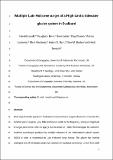Multiple Late Holocene surges of a High-Arctic tidewater glacier system in Svalbard
Abstract
Most large tidewater glaciers in Svalbard are known to have surged at least once in the last few hundred years. However, very little information exists on the frequency, timing or magnitude of surges prior to the Little Ice Age (LIA) maximum in ∼1900. We investigate the sediment-landform assemblages produced by multiple advances of the Nathorstbreen glacier system (NGS) in order to reconstruct its Late Holocene surge history. The glacier has recently undergone one of the largest surges ever observed in Svalbard, advancing ∼16 km from 2008 to 2016. We present flow velocities and ice-marginal observations (terminus change, proglacial geomorphological processes) from the later stages of this surge. A first detailed assessment of the development of a glaciotectonic mud apron within the fjord during a surge is provided. Geomorphological and sedimentological examination of the terrestrial moraine areas formed prior to the most recent surge reveals that at least two advances were responsible for their formation, based on the identification of a previously unrecognised ice-contact zone recorded by the distribution of sediment facies in coastal exposures. We distinguish between an outer, older advance to the distal part of the moraine system and an inner, younger advance to a position ∼2 km upfjord. Radiocarbon dating of shells embedded in glaciotectonic composite ridges formed by the onshore bulldozing of marine mud during the outer (older) of the two advances shows that it occurred at some point during the interval 700–890 cal. yr BP (i.e. ∼1160 AD), and not during the LIA as previously assumed. We instead attribute the inner (younger) advance to the LIA at ∼1890. By combining these data with previous marine geological investigations in inner and outer Van Keulenfjorden, we demonstrate that NGS has advanced at least four times prior to the recent 2008–2016 surge: twice at ∼2.7 kyr BP, at ∼1160 AD, and in ∼1890. This represents a unique record of the timing and magnitude of Late Holocene tidewater glacier surges in Svalbard.
Citation
Lovell , H , Benn , D I , Lukas , S , Ottesen , D , Luckman , A , Hardiman , M , Barr , L D , Boston , C M & Sevestre , H 2018 , ' Multiple Late Holocene surges of a High-Arctic tidewater glacier system in Svalbard ' , Quaternary Science Reviews , vol. 201 , pp. 162-185 . https://doi.org/10.1016/j.quascirev.2018.10.024
Publication
Quaternary Science Reviews
Status
Peer reviewed
ISSN
0277-3791Type
Journal article
Description
Much of this work was undertaken whilst HL was a PhD student at Queen Mary University of London and UNIS (The University Centre in Svalbard) funded by a NERC PhD studentship (NE/I528050/1), the Queen Mary Postgraduate Research Fund and an Arctic Field Grant from the Research Council of Norway. SL acknowledges funding from the Westfield Trust.Collections
Items in the St Andrews Research Repository are protected by copyright, with all rights reserved, unless otherwise indicated.

